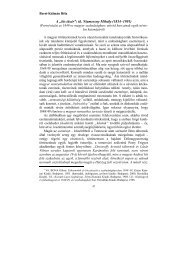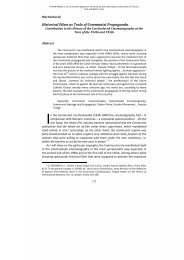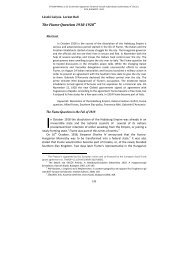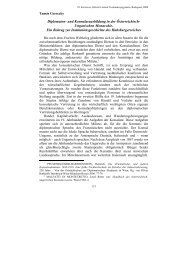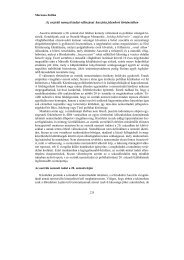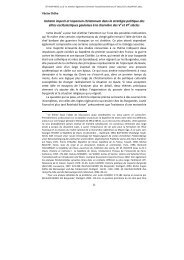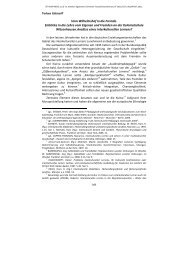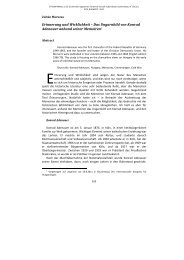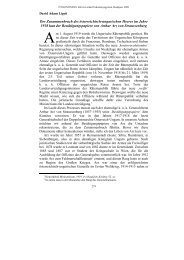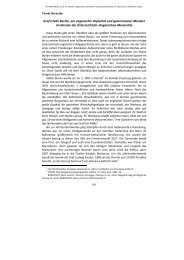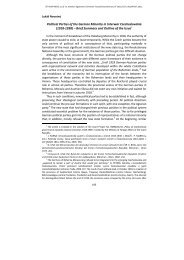The Molotov-Ribbentrop Pact - ELTE BTK Történelem Szakos Portál
The Molotov-Ribbentrop Pact - ELTE BTK Történelem Szakos Portál
The Molotov-Ribbentrop Pact - ELTE BTK Történelem Szakos Portál
You also want an ePaper? Increase the reach of your titles
YUMPU automatically turns print PDFs into web optimized ePapers that Google loves.
possible future opposition to the Soviet system. 10 <strong>The</strong> Soviet plan too intended<br />
to erase the political, military and mental leadership of Poland and to leave no<br />
opportunity for organised resistance. <strong>The</strong> mass shootings in Katyn and other<br />
places have reached sad prominence among the many crimes of this war. 11<br />
With regard to the Ukrainian and White Russian people, the Soviet<br />
propaganda claimed that the Red Army had come as a liberator from their Polish<br />
oppressors. 12 According to David Murphy, the Red Army‘s arrival was - in part -<br />
actually seen as the long-yearned liberation from the Polish yoke. He attributes<br />
this feeling in large part to the Ukrainian‘s and White Russian‘s hope for national<br />
independence. As he states, the people in these regions had no actual knowing of<br />
the Soviet state and thus no idea of what they were to expect. 13<br />
Following the statement of liberation, the former Eastern Polish territories<br />
were incorporated into the Ukrainian and White Russian SSRs respectively,<br />
according to the majority of people living in a given area. <strong>The</strong> population was<br />
ordered to elect assemblies and vote in favour of the incorporation, which they<br />
did. 14 <strong>The</strong>se votes were, as Wanda Krystina Roman puts it, the juridical and<br />
political basis for overtaking the Polish territories. 15 And George Sanford goes<br />
even further, in claiming, that the incorporation was the basis for a wide range<br />
of terror against the former Polish citizens. Passports were handed out to the<br />
inhabitants of the newly acquired territories, they became Soviet citizens; this<br />
gave the Soviet leadership not only legal power and control over its new<br />
subjects, but also unleashed the whole range of terror unto them. 16 <strong>The</strong><br />
liberators and helpers soon became prison-wards. 17<br />
10<br />
ROBERTS, Geoffrey: Stalins Kriege - Vom Zweiten Weltkrieg bis zum Kalten Krieg.<br />
Düsseldorf, 2008. 61.<br />
11<br />
For Katyn see SANFORD, George: Katyn and the Soviet massacre of 1940 - Truth, justice<br />
and memory. London, 2007. OVERY, Richard: Russlands Krieg - 1941-1945, Reinbek bei<br />
Hamburg, 2003. 95.<br />
12<br />
SANFORD, George: Katyn and the Soviet massacre of 1940 - Truth, justice and memory.<br />
London, 2007. 20. Soviet Note to the Polish government, 17th September 1939, cited from<br />
KENNAN, George F.: Soviet Foreign Policy 1917-1941. Princeton, 1960. 179.<br />
13<br />
MURPHY, David E.: What Stalin knew - <strong>The</strong> enigma of Barbarossa. New Haven, 2005. 31.<br />
14<br />
According to GROSS, the population became accomplices by taking part in these elections, as<br />
they accepted the Soviet‘s rules. GROSS, Jan T.: Revolution from Abroad - <strong>The</strong> Soviet conquest of<br />
Poland‘s Western Ukraine and Western Belorussia. Princeton, 2002. 54. By contrast Honigsman,<br />
whom one has to attribute a very subjective Soviet-Ukrainian-Jewish point of view, speaks of an<br />
atmosphere of euphoria. HONIGSMAN, Jakob: Juden in der Westukraine - Jüdisches Leben und<br />
Leiden in Ostgalizien, Wolhynien, der Bukowina und Transkarpatien 1933-1945. Konstanz, 2001. 114.<br />
15<br />
Nevertheless her Polish perspective: ROMAN, Wanda Krystina: Die sowjetische Okkupation<br />
der polnischen Ostgebiete 1939 bis 1941. In: CHIARI, Bernhard: Die polnische Heimatarmee-<br />
Geschichte und Mythos der Armia Krajowa seit dem Zweiten Weltkrieg. München, 2003. 94.<br />
16<br />
SANFORD, George: Katyn and the Soviet massacre of 1940 - Truth, justice and memory.<br />
London, 2007. 24. Sanford further explains that Stalin used these events later to claim the<br />
incorporation of these territories on the conferences of Yalta and Teheran. <strong>The</strong> treatment of Polish<br />
prisoners as counterrevolutionaries was, according to Sanford, another output of it. 40-42.<br />
17<br />
OVERY, Richard: Russlands Krieg - 1941-1945, Reinbek bei Hamburg, 2003. 93.<br />
172



